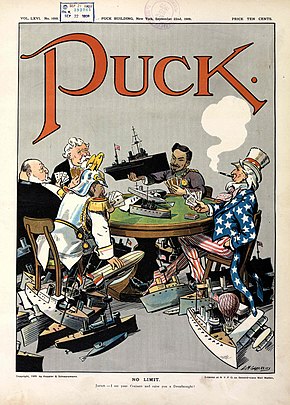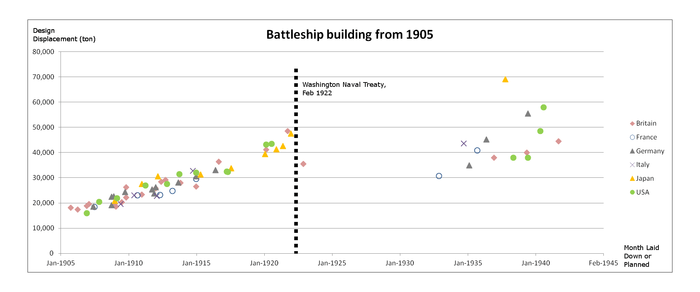Arms race
An arms race occurs when two or more nations participate in interactive or competitive increases in "persons under arms" as well as "war material". [1] Simply defined as a competition between two or more states to have superior armed forces; a competition concerning production of weapons, the growth of a military, and the aim of superior military technology.
The term is also used to describe any long-term escalating competitive situation where each competitor focuses on out-doing the others.
Examples
Pre-First World War naval arms race


From 1897 to 1914, a naval arms race between the United Kingdom and Germany took place. British concern about rapid increase in German naval power resulted in a costly building competition of Dreadnought-class ships. This tense arms race lasted until 1914, when the war broke out. After the war, a new arms race developed among the victorious Allies, which was temporarily ended by the Washington Naval Treaty.
In addition to the British and Germans, contemporaneous but smaller naval arms races also broke out between Russia and the Ottoman Empire; the Ottomans and Greece; France and Italy; the United States and Japan; and Brazil, Argentina, and Chile.
Nuclear arms race
During the Cold War, an intense period between the Soviet Union and the United States and some other countries. This was one of the main causes that began the cold war, and perceived advantages of the adversary by both sides (such as the "missile gap" and “bomber gap”) led to large spending on armaments and the stockpiling of vast nuclear arsenals. Proxy wars were fought all over the world (e.g. in the Middle East, Korea, Vietnam) in which the superpowers' conventional weapons were pitted against each other. After the dissolution of the Soviet Union and the end of the Cold War, tensions decreased and the nuclear arsenal of both countries were reduced.
Other uses
An evolutionary arms race is a system where two populations are evolving in order to continuously one-up members of the other population. This concept is related to the Red Queen's Hypothesis, where two organisms co-evolve to overcome each other but each fails to progress relative to the other interactant.
In technology, there are close analogues to the arms races between parasites and hosts, such as the arms race between computer virus writers and antivirus software writers, or spammers against Internet service providers and E-mail software writers.
More generically, the term is used to describe any competition where there is no absolute goal, only the relative goal of staying ahead of the other competitors in rank or knowledge. An arms race may also imply futility as the competitors spend a great deal of time and money, yet with neither side gaining an advantage over the other.
See also
- Arms control
- Arms industry
- Cyber arms race
- Lewis Fry Richardson for his mathematical analysis of war
- Missile gap
- One-upmanship
- Revolution in Military Affairs
- Security dilemma
- Space Race
- Weaponization of artificial intelligence
References
- Smith, Theresa Clair (1980). "Arms Race Instability and War". Journal of Conflict Resolution. 24 (2): 253–284. doi:10.1177/002200278002400204.
Literature
- Barnet, Richard J. 1984. Der amerikanische Rüstungswahn. Reinbek: Rowohlt ISBN 3-499-11450-X (in German)
- Bruhn, Jürgen. 1995. Der Kalte Krieg oder: Die Totrüstung der Sowjetunion. Gießen: Focus ISBN 3-88349-434-8 (in German)
- Intriligator, Michael D., and Dagobert L. Brito. "Can arms races lead to the outbreak of war?." Journal of Conflict Resolution 28.1 (1984): 63–84. online
- Mitchell, David F., and Jeffrey Pickering. 2018. "Arms Buildups and the Use of Military Force." In Cameron G. Thies, ed., The Oxford Encyclopedia of Foreign Policy Analysis, vol. 1. New York: Oxford University Press, 61–71.
- Smith, Theresa Clair. "Arms race instability and war." Journal of Conflict resolution 24.2 (1980): 253–284.